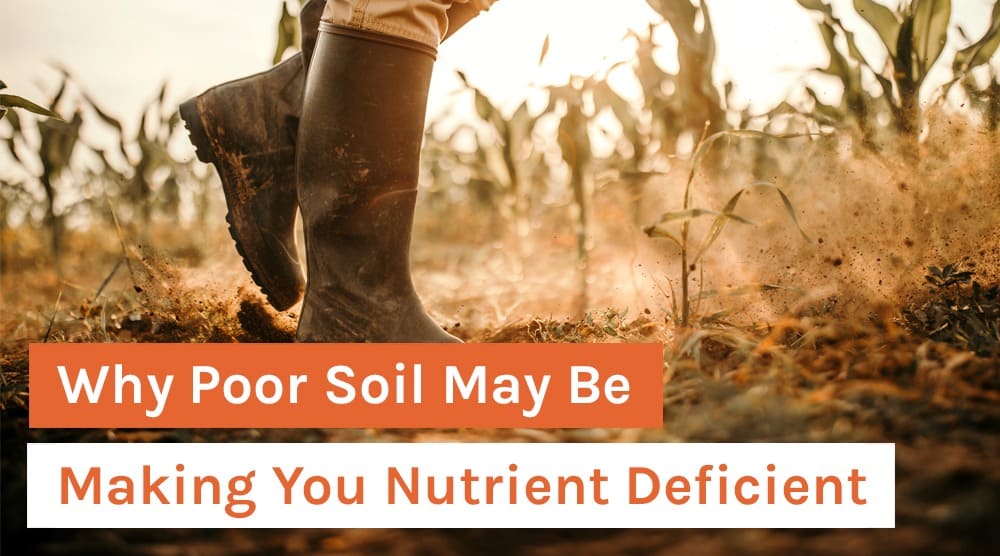Why Poor Soil May Be Making You Nutrient Deficient
In a hurry? Click here to read the Article Summary...
“Eat more veggies.” This what many experts say is the most important thing you can do for your health.
But can you actually get all the essential vitamins and minerals your body needs solely from the food you consume? To answer that question, let’s review the findings of some studies on soil depletion and its impact on nutrients in our modern times.
U.S. Soil Depletion: 1950s vs. 1999
If you have a suspicion that the food you are eating today (including produce) isn’t what it used to be, you would be right. As it turns out, research is pointing to a food production situation that is vastly different than it was only a few decades ago.

One of the most comprehensive investigations to date occurred through the University of Texas (U of T) in the early 2000s.
Researchers there embarked on a massive meta-analysis of U.S. Department of Agriculture data for Americans crops grown between 1950 and 1999.
They studied the nutrient values for 43 of the most common vegetables and fruits, measuring many essential vitamins and minerals then and now. They found significant declines in calcium, iron, protein, vitamin C, and vitamin B2. In some cases, nutrient levels were reduced by close to 40%.
The authors of this ground-breaking analysis also concluded that the “preponderance of agricultural practices,” which began in earnest with higher-yielding techniques as well as increased pesticide use in the 1950s [1], were most responsible for the decline.
“During those 50 years, there have been intensive efforts to breed new varieties that have a greater yield, or resistance to pests, or adaptability to different climates. But the dominant effort is for higher yields,” said Professor Donald Davis of U of T’s Department of Chemistry and Biochemistry Biochemical Institute.
Emerging evidence suggests that when you select for yield, crops grow bigger and faster, but they don’t necessarily have the ability to make or uptake nutrients at the same, faster rate.
In an interview for Scientific American [2], Davis explained that there “have likely been declines in other nutrients too” such as magnesium, zinc, vitamin B6 and vitamin E, but those were not studied in the data collected by the USDA during the 1950s, so they were not included in the U of T report.
U of T’s evidence may be the most massive, but it is by no means the only study to prove that nutrient quality has plummeted in recent years. A more recent 2005 report written by the Kushi Institute’s Alex Jack cites USDA data that makes the same point [3].
According to the report, the average calcium levels in a dozen vegetables dropped 27% between 1975 and 1997. Iron levels dropped 37%, vitamin A declined by 21%, and vitamin C declined by 30% during those same years.
Finally, one of the scariest reports to date claims that, if soil degradation continues at the current rate, within 60 years there will not be any more viable land left to farm at all.
“We are losing 30 soccer fields of soil every minute, mostly due to intensive farming,” said activist Volkert Engelsman in a 2014 interview for Reuters [4]. Engelsman works for the International Federation of Organic Agriculture Movements.
This fact, coupled with the realization that it takes about a thousand years to generate only three centimeters of quality topsoil, means that future generations may be inheriting a crisis that extends way beyond individual health.
The Link Between Modern Agriculture & Iodine Deficiency
What happened to the croplands of the U.S. Midwest in the early part of the 20th century and subsequent iodine deficiencies region-wide is one small example of the connection between modern agriculture and health.
Iodine is possibly one of the most important minerals for your body, yet by the 1910s the people of what is now referred to as the “goiter belt” relied on government-mandated iodine supplementation to fend off goiter and other thyroid-related diseases. A report put out by Boston Medical Center in 2012 found that between 26 and 70% of children in the area in the 1920s had “clinically apparent goiter [5].” [Note: a goiter is a swelling on the neck caused by an enlargement of the thyroid gland.]
So what happened? Before the late 1800s, the people of this region produced and ate crops that were traditionally high in iodine, namely spinach, cranberries, and dairy [6].
As the years went on, priorities changed. High-yield agricultural practices became all the rage, and subsequently, the soil became more and more depleted of essential nutrients – including iodine. The result was goiter and other thyroid/iodine-deficiency related issues.
Keep in mind, all these iodine deficiency-related problems occurred in the early years of modern agriculture, before major pesticide use and GMO crops became standard. Nowadays, pesticide residue on commercial produce, preservatives such as BHA, and hormones and antibiotics that are fed to U.S. livestock all come with their own set of problems that affect the ability of our bodies to absorb and utilize nutrients.
Subclinical Nutrient Deficiencies Are on the Rise
Despite iodine fortification in salt, deficiency of this essential nutrient is still a major concern worldwide. You may not see large areas of the country where goiter is widespread, but the consequences of long-term iodine deficiency are just as insidious. This is because they are a result of “subclinical” deficiency. As you will see, this is true not only for iodine but for other nutrients as well.
The concept of subclinical deficiency is not well-known, mainly because of the way the federal government has determined RDAs of various nutrients throughout the years. For the most part, the Recommended Daily Allowance – now called Dietary Reference Intakes (DRIs) or Daily Values (DVs) – represents the minimum quantity of a substance that a person needs to prevent diseases directly related to that deficiency.
 For example, the adult RDA for iodine of 150 μg/day will prevent goiter, and that is about it. The RDA for vitamin C of 60 mg/day will prevent scurvy but is not enough to provide immune support and cardiovascular health, according to the Linus Pauling Institute [7].
For example, the adult RDA for iodine of 150 μg/day will prevent goiter, and that is about it. The RDA for vitamin C of 60 mg/day will prevent scurvy but is not enough to provide immune support and cardiovascular health, according to the Linus Pauling Institute [7].
Also, experts have long called into question the accepted RDA for vitamin D. Research now shows that this is simply not enough for robust reproductive and endocrine health and even to adequately prevent breast cancer.
In fact, in 2015 researchers at UC San Diego and Creighton University stated that the National Academy of Sciences Institute of Medicine (NAS-IOM)’s Recommended Daily Allowance of 25ng/ml per day was off by a factor of ten [8].
Their decision was based on a 2014 UCSD breast cancer study which found that when vitamin D blood levels were raised to 50ng/ml from 25, the incidence of breast cancer was reduced by 83% [9]. They found similar results for colon cancer.
According to physician and best-selling author Dr. Mark Hyman, 92% of Americans chronically suffer from at least one vitamin or mineral deficiency [10]. Indeed, a survey conducted by the USDA itself found that 37% of Americans are still deficient in vitamin C and a whopping 75% do not get enough zinc [11]. Zinc, by the way, is essential for a healthy immune system [12].
The low RDA for many key nutrients goes hand-in-hand with low nutrient quality in American fruits and vegetables. The soils of the U.S. may yield crops that live up to what the government says are healthy amounts of essential minerals like iodine and essential vitamins like C. But what research (and your body) says is another story.
4 Tips for Staying Strong in a Nutrient-Depleted World
Want to ensure you’re getting all the vitamins and minerals your body needs despite soil depletion of nutrients? Here are four steps you can implement:
#1. Go Organic and Non-GMO.
You may have noticed that we did not mention the difference in nutrient content in organic foods versus non-organic foods nor that of GMO-foods versus GMO-derived foods.
This is not meant to downplay the vast importance of purchasing and consuming organic foods every chance you get and to stay away from GMOs as if your life depended on it (which is most certainly does!). Choosing organic and non-GMO can go a long way toward helping you reach your health goals.
That being said, nutrient depletion in vegetables and fruits is caused by nutrient depletion in the soil – and this is a worldwide problem for both commercial and organic foods.
Unfortunately, even if you pick up a basket of strawberries or a head of lettuce straight from the organic aisle in your grocery store, you are still not going to receive all the nutrient goodness that the same fruit or vegetable had even 25 years ago.
Still, experts across the board agree that even though our food may not have as much nutrition as it did in decades gone by, it is still vitally important to eat your greens, brightly colored root vegetables, fresh fruits like berries, and cruciferous vegetables. Fresh vegetables and fruit contain fiber and phytonutrients “straight from the source,” and you are not going to find them in that combination anywhere else.
#2. Head for the farmer’s market.
If you want to ensure that you get THE MOST nutrient density from your fruits and veggies, then going straight to the source is your best bet. Buying directly from the farmer ensures that you are getting produce that has recently been picked and has not had to travel far from their field to your refrigerator.
from your fruits and veggies, then going straight to the source is your best bet. Buying directly from the farmer ensures that you are getting produce that has recently been picked and has not had to travel far from their field to your refrigerator.
Nutrients are at their peak the moment produce is picked, which is why frozen produce can sometimes contain more nutrients than fresh if it was processed immediately after harvest.
If at all possible, also purchase your produce from farmers who use “heirloom” varieties. For example, a purple carrot, often seen at many local farmer’s markets, has approximately 38 milligrams of phytonutrients, while an orange carrot has only 2.5 milligrams [13].
#3. Heal your gut.
It doesn’t matter if you are eating the most nutrient-dense foods in the world – if your body can’t absorb those nutrients, they aren’t going to do you any good. Malabsorption, also known as dysbiosis, is a serious issue worldwide [14].
The challenge with dysbiosis lies in the gut, and the solution is simple: heal your digestive system and restore the proper balance of gut flora in your microbiome. Then you will be better able to utilize all the wonderful nutrients you are putting into your body from the good food and quality supplements you are ingesting.
#4. Consider supplementation.
Finally, there is the option of supplementation. While many people claim that they can still get all the nutrients they need by carefully choosing the right kinds of food for them, many experts today (and a lot of research into soil depletion as noted above) say otherwise.
If you decide to supplement, make sure the product ingredients are of the highest quality and are in a form that is bioavailable so your body can readily absorb the precious nutrients you’re paying for.
If you’re not getting all the nutrients and antioxidants you need from food, your best source is whole food vitamins. Organixx Multi-Vita-Maxx contains 21 uniquely fermented vitamins and enzyme-activated minerals that are more “bioavailable” and easily absorbed by your body than the synthetic compounds found in most supplements.

 Sources:
Sources:
Article Summary
We are finding a significant decline in calcium, iron, protein, vitamin C, and vitamin B2 in our food. Some reports show up to 40%
What happened? High-yield agricultural practices became all the rage, and subsequently, the soil became more and more depleted of essential nutrients.
Despite iodine fortification in salt, deficiency of this essential nutrient is still a major concern worldwide.
4 Tips for Staying Strong in a Nutrient-Depleted World
- Go Organic & Non-GMO
- Head for the farmer’s market
- Heal Your Gut
- Consider Supplementation
If you decide to supplement, make sure the product ingredients are of the highest quality and in a bioavailable form so your body can readily absorb the precious nutrients you’re paying for. We recommend Organixx Multi-Vita-Maxx.




Should a person do your detox program BEFORE taking the mutimax (liquid/capsules)? Or can you take the mutivitamins/minerals while doing the dtox? So curious to know this andwer!!!
Hello, Susan! You can do the Detoxx program while taking the Liquid Multi-Vita-Maxx and or other supplements. Regarding your question of consuming all of the Organixx products at the same time, Organixx researches and develops a broad range of nutritional supplements to assist people in accomplishing a wide range of health goals. Some of our supplements are developed and designed to be taken together, as a system. Others were created for a more specific, targeted health goal. While most should have no issue consuming all of our nutritional supplements together, it is always a wise step to consult with your primary healthcare practitioner related to your own unique health needs and health challenges. When taking multiple products in conjunction with one another, you can always start slowly with smaller doses and gradually work your way up to the recommended dosage per product.
Nice article pointing out an often overlooked topic, the soil. Purchasing topsoil in my area has proven to be unfruitful, it's dead and grows weak pitiful plants. Developing good soil is a gardeners main challenge and takes time. My plan to get a small garden going is to scrape up topsoil from the woods which hasn't been farmed in half a century and build up from there. I've seen some buying topsoil in bags from home improvement stores like miracle grow producing good looking plants but bet if an analysis was done on the plants nutrients they're covered in chemicals even if present. But they look terrific. And remember to use well water if available.
Thank you for sharing, Richard. We truly appreciate it!
Soil regeneration in as little as three to four years is a primary focus of Bio-Dynamic farming methods developed over decades from the teaching of Rudolph Steiner.
Totally compatible with no-chemical and natural farming like organic, in fact it may be the first scientific methodology applied to farming that embodied the knowledge of centuries.
Healthy nutrient rich food can only be grown in healthy nutrient rich soil. Human life depends upon this fundamental practice.
We appreciate your feedback regarding this topic, Peter. Thank you!
I feel bad, I could not read the article on the orange background. Only where something was written in bold could I read it.
After I posted my comment, the background became white and now I can read it.
Thanks for letting us know, Eva!